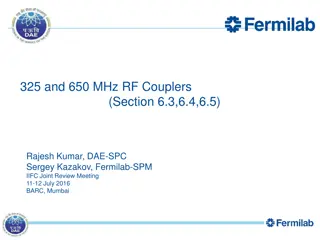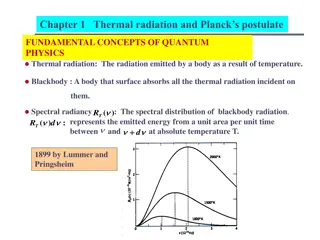Thermal and Mechanical Simulation of Beryllium Window for MICE 201 MHz Cavity
Conducted thermal and mechanical simulations using TEM3P for the beryllium window of the MICE 201 MHz cavity. Analysis focused on temperature distribution, frequency shifts, thermal deformation control, and stress considerations under varying operation conditions and material properties. Detailed insights into the impact of RF heating on window deformation and frequency drift were examined through ANSYS stress analysis and TEM3P simulations.
Download Presentation

Please find below an Image/Link to download the presentation.
The content on the website is provided AS IS for your information and personal use only. It may not be sold, licensed, or shared on other websites without obtaining consent from the author.If you encounter any issues during the download, it is possible that the publisher has removed the file from their server.
You are allowed to download the files provided on this website for personal or commercial use, subject to the condition that they are used lawfully. All files are the property of their respective owners.
The content on the website is provided AS IS for your information and personal use only. It may not be sold, licensed, or shared on other websites without obtaining consent from the author.
E N D
Presentation Transcript
Thermal and Mechanical Simulation of Beryllium Window of MICE 201 MHz Cavity by TEM3P Tianhuan Luo, Derun Li Center of Beam Physics Lawrence Berkeley National Laboratory MAP Spring Workshop May 2014 1
Be windows for MICE 201 MHz cavity R=210 mm, thickness=0.38 mm. Double curvature profile: minimize the thermal stress from RF heating, control the thermal deformation direction. Curved in the same direction: partially cancels the frequency shift caused by the window thermal deformation. 2
TEM3P simulation for MICE 201MHz Cavity TEM3P is part of the SLAC ACE3P suite for thermal and mechanic simulation. For the Be window of MICE 201 Cavity, we are majorly interested : The temperature distribution The slow frequency shift due to the thermal deformation The dynamic frequency shift due to Lorentz force The overall stress on the window (so far can t do this analysis yet). For the simplicity, the copper shell is fixed at 293 K and zero mechanical movement. Cavity operation condition: effective E field from 2 MV/m to 16 MV/m, where 8 MV/m is the nominal operation for MICE and 16 MV/m for Neutrino Factory; duty factor 0.001. Copper and Beryllium material properties: see Appendix A. 3
Temperature distribution ANSYS Stress analysis by S.V. Temperature T (K) Curved in Curved out Radius R (m) Curved in window heats more than curved out window due to larger surface B field. Previously ANSYS simulation by Steve Virostek T_center=359 K at 16 MV/m, consistent with TEM3P result of 361 K. For nominal MICE operation at 8MV/m, T_center= 310 K. 4 E field (MV/m)
Thermal Deformation (1) Curved in Displacement (m) The RF heating on two windows are different, resulting different thermal deformations, thus the frequency drifts with the input power. Curved out Radius R (m) Curved in dX (um) Curved out 5 E_eff (MV/m) E_eff (MV/m)
Thermal Deformation (2) E_eff (MV/m) Previous ANSYS simulation by Steve Virostek shows max_|df| =94 KHz, while TEM3P simulation gives max_|df|=110 KHz. This small difference is mainly due to the slightly different thermal expansion coefficient and cooling condition between two models. For nominal MICE operation of 8 MV/m, df= -24 KHz, well within the designed tuning range of RF tuner +/- 500 KHz. 6
Lorentz Force Detuning (1) ( ) 1 Equivalent pressure from Lorentz Force: = 2 2 p H E 0 0 4 LFD has been studied mainly in superconducting RF cavity, due to the low tolerance of the frequency shift and thin cavity wall. To compensate LFD Increase cavity stiffness; not applicable to Be window. Increase input power; only applicable to small detuning. Dynamic tuning with Piezo. dX (um) Curved in Curved out 7 E_eff (MV/m) E_eff (MV/m)
Lorentz Force Detuning (2) Cavity Bandwidth (BW) f Q L = 0 f f MHz 25 . 201 = = 8 . 7 KHz f 0 26000 Q L 1 = 9 . 3 KHz f 2 E_eff (MV/m) LFD is much smaller than the thermal detuning. For nominal MICE operation 8 MV/m, df=-1.4 KHz, which is within the cavity BW. But when operated above 14 MV/m, |df | > 3.9 KHz, which is out of the cavity BW, thus the procedure to compensate LFD needs to be considered. The LFD from the copper wall is much smaller compared with Be window, with |df|~0.02 KHz at 16 MV/m. 8
Summary TEM3P simulation of MICE 201 MHz cavity has been carried out. The temperature and thermal deformation results have been benchmarked with previous ANSYS simulation by Steve Virostek. The frequency shift due to thermal stress is well within the designed tuning range of cavity RF tuner up to 16 MV/m. The frequency shift due to the LFD is within the cavity BW for nominal MICE operation at 8 MV/m. But when the effective E field is above 14MV/m, the simulation shows the LFD will detune the cavity out of its BW and the compensation procedure might need to be implemented. 9
Appendix A The thermal and mechanic parameters of Beryllium and Copper used in the simulation is listed here: Cu Be Electric conductivity (S/m) 5.8e7 2.3e7 Thermal conductivity (W/m/K) 391 200 Coefficient of thermal expansion (1/K) 1.7e-5 1.2e-5 Lame constant (Pa) 8.1e10 0.9e10 Shear modulus (Pa) 4.3e10 1.5e11 10
Thank You! 11























